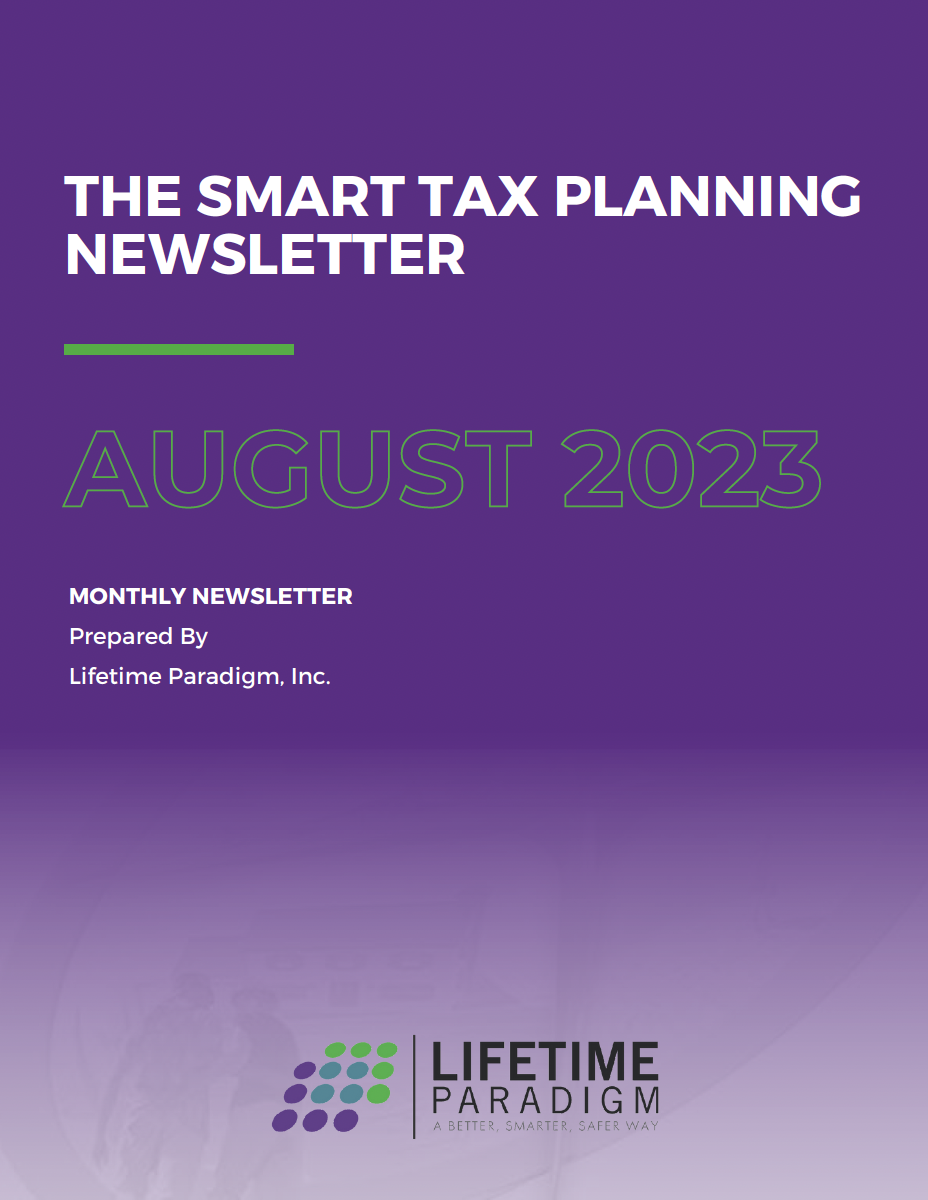Tax Planning
The Smart Tax Planning Newsletter August 2023
In this issue:
- ICHRA Unleashed: Transforming Small Business Health Benefits
- Key Insights on the ICHRA for Small Businesses
- Update on State Pass-Through Entity Taxes Beating the SALT
ICHRA Unleashed: Transforming Small Business Health Benefits
The individual coverage health reimbursement arrangement (ICHRA) allows businesses of all sizes, from large corporations to very smallest of businesses to reimburse employees for their personally purchased health insurance expenses. The ICHRA is particularly beneficial for businesses with fewer than 50 employees because they are not obligated to provide health benefits under the Affordable Care Act. However, when they do provide coverage, they expose themselves to a $100-per-day penalty for each employee. The ICHRA avoids this penalty.
The ICHRA offers several benefits to the employer, including:
- The flexibility to choose the reimbursement limits, which both controls your costs and minimizes your expenses…
- The ability to offer different plans to different employees based on classifications, and…
- The ability to offer a cafeteria plan that allows employees to pay pre-tax for additional insurance coverage above what the ICHRA reimburses.
There are restrictions on who can participate. Employees eligible for an ICHRA are those enrolled in individual exchange coverage, other individual insurance coverage, or Medicare. More-than-2% S corporation shareholders, their family members, and Form 1040, Schedule C taxpayers are not eligible to participate in an ICHRA.
If you plan to offer an ICHRA, you need to provide your employees with at least a 90-days’ notice before the beginning of the plan year. We encourage you to start planning now if you wish to offer an ICHRA on January 1, 2024, as this gives you a target date for the ICHRA notice of October 2, 2023.
Key Insights on the ICHRA for Small Businesses
If you are thinking about offering your employees the new ICHRA, take a moment to read the insights below.
Class size rule –You face the class size rule only if you offer a traditional group health plan to one class of employees and an ICHRA to another.
Minimum class size example: You cover four full-time employees with group health coverage and offer an ICHRA of $400 a month to your 12 part-time employees. Eight of the part-time employees accept. You satisfy the “same terms” rule and meet the class size requirement.
No minimum class size example: You face no minimum class size requirements when you don’t offer a traditional group health plan. Say you have seven employees. You can offer a $16,000 ICHRA to your two salaried employees and a $5,000 ICHRA to your five hourly employees.
Carryover rules: You can establish your ICHRA so employees can carry over unused amounts to next year.
Section 125 Plan Strategy
You can use a cafeteria plan (a Section 125 plan) to let those employees who purchase individual health insurance coverage outside of a public exchange pay the uncovered part of the premium, which allows you and your employees to save on taxes.
Avoiding the $100-Per-Day-Per-Employee Penalty
The ICHRA avoids the Affordable Care Act’s $100-a-day-per-employee penalty for reimbursing individually purchased health insurance.
Not Subject to Affordability Rules
Businesses with fewer than 50 employees are not subject to affordability rules under Section 4980H, providing additional flexibility.
Qualifying insurance
Insurance that qualifies for the ICHRA includes individual coverage purchased through an exchange or on the open market, and Medicare.
As you can see, an ICHRA has several advantages for a small business. It’s not a perfect solution, however, and it is complicated so be sure to consult with your licensed tax professional before taking any action to implement these plans for your business.
Update on State Pass-Through Entity Taxes Beating the SALT
As part of the Tax Jobs and Cuts Act, a limit was placed on the amount of local taxes individuals can deduct from their federal taxes. Almost since the day that law was approved by Congress, States with high income taxes having been working on and implement workarounds to give that benefit back to their State’s residents. Here are some critical updates on the pass-through entity tax (PTET), which has recently become the rule in most states rather than the exception.
The PTET enables owners of pass-through businesses, such as S corporations and multi-member LLCs, to navigate around the $10,000 annual limit on state and local taxes (SALT).
How PTET Works
The PTET process is relatively straightforward. A pass-through entity (PTE) can choose to pay state income tax on its business income, which would otherwise pass on to its owners. The PTE then claims a federal business expense deduction for these state income tax payments. Next, the states allow the owners to claim a credit or a deduction for these taxes, which avoids the SALT limit. Consequently, owners benefit from the federal deduction against their state income tax and avoid the $10,000 SALT limit on some or all their pass-through income.
State Updates
Currently, 36 of the 41 states imposing income taxes have adopted some form of PTET. So far, in 2023, Hawaii, Indiana, Iowa, Kentucky, Montana, Nebraska, and West Virginia have enacted a PTET. Of these, Indiana, Iowa, Kentucky, and West Virginia have made their PTET retroactive to 2022, while Nebraska’s new PTET is retroactive to 2018. Hawaii’s and Montana’s PTETs are not retroactive. Interestingly, States with low- or no-income tax have not implemented a workaround. The argument is that, with no state income tax, there is no need for a workaround. That said, I’ve reviewed tax returns for my clients living in Florida, for example, and while do not have to pay income taxes their property taxes push them above the $10,000 threshold. Think about the irony.
Eligibility
In all states with a PTET, partnerships, S corporations, and multi-member LLCs taxed as partnerships or S corporations are eligible to elect to pay a state PTET. Sole proprietorships, single-member LLCs taxed as sole proprietorships, C corporations, trusts in most states, and LLCs taxed as C corporations are not eligible.
Deadline for PTET Election
No state (except Connecticut) requires a PTE to pay a state PTET; the PTE must elect to do so. The due dates for making the PTET election vary from state to state.
PTET Opt-Outs
In most states, a PTET election is binding on all the PTE’s owners, and individual owners cannot opt-out. The only exceptions are Arizona, California, New York, and Utah.

SERVICES WE OFFER RELATED TO THIS TOPIC
The information contained in this post is for general use and educational purposes only. However, we do offer specific services to our clients to help them implement the strategies mentioned above. For specific information and to determine if these services may be a good fit for you, please select any of the services listed below.
The 4x4 Financial Independence Plan ℠
Estate Planning
Retirement Planning
Tax Planning
Coaching and Consulting
EP 0012. The Three Generations of Annuities
The Financial Independence Now Podcast Hosted by Randy LuebkeIn Episode 12 of the Financial Independence Now podcast,...
11 Financial Tips to Make Caregiving Easier
Tax Planning Caregivers generally tend to their elderly/ disabled family members as a labor of love, but it can also...
EP 0011. Budgeting for Dummies
The Financial Independence Now Podcast Hosted by Randy LuebkeIn this episode of Financial Independence Now, host Randy...
Investment Advisory Services are offered through Lifetime Financial, Inc., a Registered Investment Advisory. Insurance and other financial products and services are offered through Lifetime Paradigm, Inc. or Lifetime Paradigm Insurance Services. Neither Lifetime Financial, Inc. nor Lifetime Paradigm, Inc., or its associates and subsidiaries provide any specific tax or legal advice. Only guidance is provided in these areas. For specific recommendations please consult with a qualified, licensed Advisor. Past performance is no guarantee of future results. Your results can and will vary. Investments are subject to risk, including market and interest rate fluctuations. Investors can and do lose money and, unless otherwise noted, they are not guaranteed. Information provided is for educational purposes only and is not intended for the sale or purchase of any specific securities product, service or investment strategy. BE SURE TO FIRST CONSULT WITH A QUALIFIED FINANCIAL ADVISER, TAX PROFESSIONAL, OR ATTORNEY BEFORE IMPLEMENTING ANY STRATEGY OR RECOMMENDATION DISCUSSED HEREIN.
This message is intended for the use of the individual or entity to which it is addressed and may contain information that is privileged, confidential and exempt from disclosure under applicable law. If you are not the intended recipient, any dissemination, distribution or copying of this communication is strictly prohibited. If you think you have received this communication in error, please notify us immediately by reply e-mail or by telephone (800) 810-1736 and delete the original message.
This notice is required by IRS Circular 230, which regulates written communications about federal tax matters between tax advisors and their clients. To the extent the preceding correspondence and/or any attachment is a written tax advice communication, it is not a full "covered opinion." Accordingly, this advice is not intended and cannot be used for the purpose of avoiding penalties that may be imposed by the IRS.





